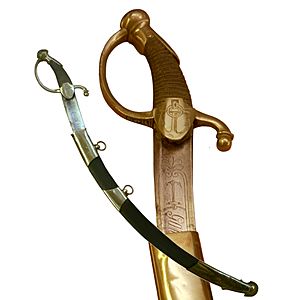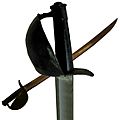Sabre facts for kids
Quick facts for kids Sabre |
|
|---|---|
|
Sheathed French sabres of the sailors of the Guard, First French Empire
|
|
| Type | Sword |
| Service history | |
| Wars | Early Modern warfare, Ottoman Wars, Napoleonic Wars, American Revolution, American Civil War, Franco-Prussian War, Philippine Revolution, Spanish–American War, Philippine–American War, World War I, Polish–Soviet War |
| Production history | |
| Produced | Early modern period |
A sabre (pronounced SAY-bur) is a special kind of sword. It has a curved blade and is sharp on one side. Sabres were very popular with light cavalry (soldiers on horseback who moved quickly) during the early modern period and the time of Napoleon.
Sabres were first used in Central and Eastern Europe. Groups like the hussars (a type of cavalry) were famous for using them. Later, sabres became common in Western Europe during the Thirty Years' War. Even some foot soldiers started using lighter sabres in the late 1600s.
Contents
What is a Sabre?
A sabre is a backsword, which means it has a sharp edge on one side of the blade and a dull, thicker back. This design makes the sword strong and good for cutting. The curved shape of the blade helps it make powerful slicing cuts when used from horseback.
Sabre Design Over Time
Over the years, the design of sabres changed. In the 1800s, some sabres had less curved blades. These were also used by heavy cavalry, who were soldiers on horseback with heavier armor and weapons.
The last sabre given to US cavalry soldiers was the Patton saber in 1913. In Poland, the Szabla wz. 34 was the last sabre given to their cavalry in 1934. This shows that sabres were used in armies for a very long time, even into the 20th century.
Sabres in Sports
Sabres were not just used in wars. In the 1800s, they became a weapon for duelling in academic fencing. This led to the modern sport of sabre fencing.
Modern Sabre Fencing
Sabre fencing is a sport that was first included in the 1896 Summer Olympics. It is based on how the historical sabre was used. In sabre fencing, athletes can score points by both cutting (slicing) and thrusting (stabbing) with their special fencing sabres. This makes it different from other fencing styles like foil or épée, where only thrusts are allowed.
Images for kids
-
The briquet, typical infantry sabre of the Napoleonic Wars
See also
 In Spanish: Sable para niños
In Spanish: Sable para niños







